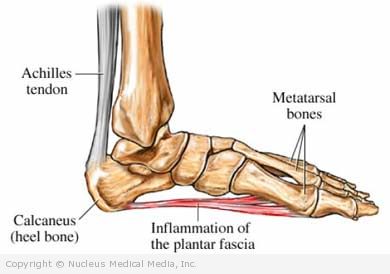Plantar fasciitis
Plantar fasciitis – Definition
Plantar fasciitis is inflammation of the plantar fascia. The plantar fascia is a thick band of tissue attached to the heel bone that supports the arch of the foot.
Plantar fasciitis – Causes
Plantar fasciitis is caused by activity that puts extra stress on the foot, such as:
- Physical exertion, especially in sports that require running and jumping such as:
- Running
- Volleyball
- Tennis
- Sudden increase in exercise intensity or duration
Plantar fasciitis – Risk Factors
A risk factor is something that increases your chance of getting a disease, condition or injury. The main risk factor for plantar fasciitis is physical activity that stresses the plantar fascia.
Other risk factors include:
- Abrupt changes in activity or physical forces endured by the feet
- Obesity or weight gain
- Weight gain
- Pre-existing foot problems, including an abnormally tight Achilles tendon (heel cord), flat feet, overpronation, or unusually high arches
- Poor footwear
- Poor general conditioning
Plantar fasciitis – Symptoms
Symptoms of plantar fasciitis may come on gradually or suddenly.
Symptoms include:
- Burning pain on the sole of the foot
- Heel pain when taking the first steps in the morning
- Tenderness when touching the sole or heel
- Pain when standing on tiptoe
Plantar fasciitis – Diagnosis
The doctor will ask about your symptoms and medical history, and examine your foot.
Tests may include:
- X-ray or bone scan of the foot — to help rule out stress fractures or other bone abnormalities
Plantar fasciitis – Treatment
Treatments include:
Rehabilitation Measures to Reduce Plantar Fascia Irritation
- Activity
- Avoid running and other activities that may worsen pain.
- Begin stretching exercises to lengthen the Achilles tendon and plantar fascia as recommended by a healthcare professional. This is usually done when the acute pain has resolved or improved.
- Ice — Apply ice or a cold pack to the heel and arch for 15 to 20 minutes, 4 times a day to relieve pain. Wrap the ice or cold pack in a towel. Do not apply the ice directly to your skin.
- Night splint — A special splint that will hold your foot in a neutral position while sleeping.
- Orthotics — Special shoe inserts provide support for the mid-arch region of your foot. Prefabricated inserts may work just as well as customized ones.
Medication
The following medications can relieve pain and inflammation:
- Ibuprofen (Motrin, Advil)
- Naproxen (Aleve, Naprosyn)
- Acetaminophen (Tylenol)
- Aspirin
Procedures
Corticosteroid injections are controversial, but may be an option in some cases (may be given by a doctor). In certain cases, a new special type of sound wave called, extracorporeal shock wave, may be appropriate (also under the care of your doctor). At this time, this is generally a treatment for chronic, refractory cases.
Surgery
In a few cases, basic treatments don’t help, and surgery is performed to cut the tight, swollen fascia. Heel spurs have not been proven to cause plantar fasciitis, and they do not need to be routinely surgically removed.
Plantar fasciitis – Prevention
To reduce your risk of getting plantar fasciitis:
- Wear appropriate and well-fitted footwear during sports and exercise.
- Do stretching exercises for the Achilles tendon and plantar fascia.
- Increase intensity and duration of exercise gradually.
- Maintain an appropriate weight.

